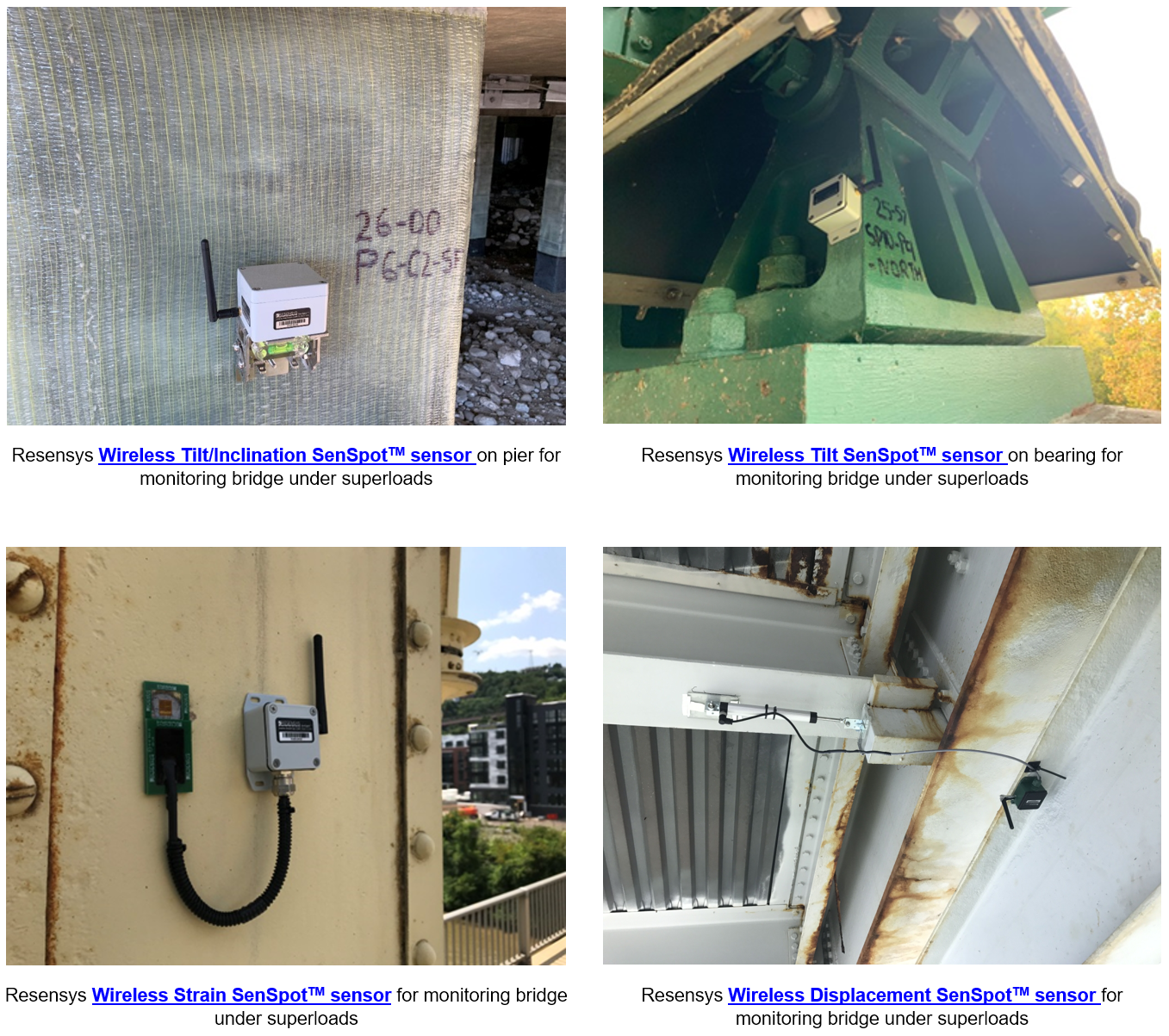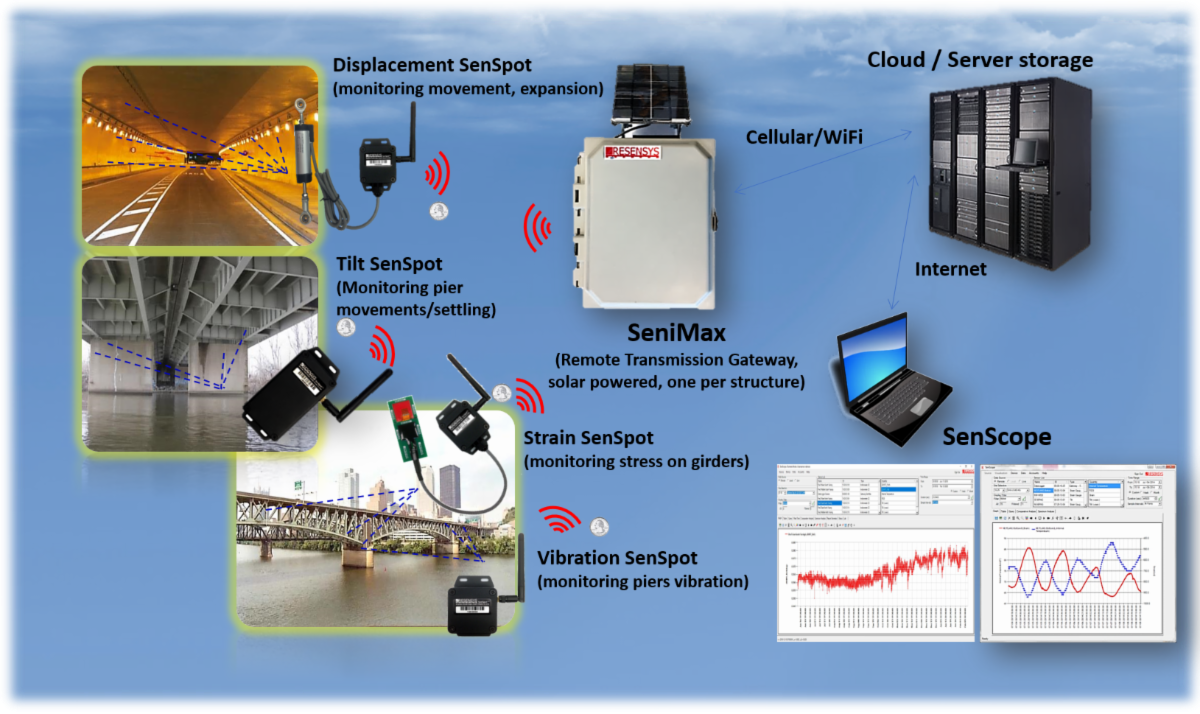Home > Applications > Bridge Monitoring > Remote Monitoring of Bridges under Extreme Permit Loads or Superloads
Extreme Loads or Superloads are deemed the transportation of loads that are generally greater than 200 tonnes. According to FHWA, the following are the Federally mandated maximum weights for the National System of Interstate and Defense Highways and reasonable access thereto for “routine permit limits” (23 CFR Part 658.17):
1- 80,000pounds gross vehicle weight
2- 20,000pound single axle weight
3- 34,000pound tandem axle weight
Axle spacing is another consideration that must be taken into account when looking at Federal weight compliance. To protect bridges, the number and spacing of axles carrying the vehicle load must be calculated. Thus, a bridge weight formula is also applied to commercial vehicles in determining their compliance with Federal weight limits. The Federal bridge formula applies when the gross weight on two or more consecutive axles exceeds the limitations of the formula, except that two consecutive sets of tandem axles may carry a gross load of 34,000 pounds each if the overall distance between the first and last axle is 36 feet or more.
W = 500(LN/N - 1 + 12N + 36); where W=overall gross weight on any group of 2 or more consecutive axles to the nearest 500 pounds. L = distance in feet between the extreme of any group of 2 or more consecutive axles, and N = number of axles in the group under consideration.
Also, the Federal government does not issue permits for oversize or overweight vehicles. This is a State option i.e. each state has its own regulation for these purposes.
The states have a broad range of what is considered a superload. In general, however, a super load is when the load exceeds the dimensions of a state’s “routine permit limits” and is non-divisible, meaning it can not be broken down into smaller parts for shipping. Click here for more information about extreme/ overweight loads permits and US states regulation.
So, a superload is going to exceed the routine permit limits typically in the following ways: Length, Width, Height and Weight. The load could exceed just one of these limits or a combination of limits. Again, this will depend on the state’s rules. Another key consideration when hauling a super load is that it often takes more time to get state approval and can also require the following: State Approval (weeks to months), Engineering Survey, Utilities Involvement, Route Survey, Police Escorts, Pilot Cars, Permits, Shipper’s Letter, Bridge Analysis, Drawing or Sketch of Shipment.
States can vary; for example, New York says a load at 200,000 lbs or over is a superload where Massachusetts says that over 130,000 lbs is a super load. Also, these two states share a border with each other.
In the realm of superload hauling, it can be obtained in very wide range of dimensions. If a shipment falls in super load status it can be found that a two weeks load time is required by a state where another super load which is much bigger requires months of planning.
Often, superloads are consisted of multiple components like jeeps, dollys, stingers, trailers, and boosters. In the case of lift axles, some states allow for lifting of axles during turns where they may damage tires, roads, or hinder the driver in completing a turn.
When a sketch is required for a super load typically the states are looking for the following information: Axle Loadings, Axle Spacing, Tire Size, Tires per Axle and Dimensions.
Superloads can also be shipped by barge or rail and if that is a viable alternative it must be considered or an explanation provided why it’s not a solution.
This kind of tests and monitoring ensures the integrity and public safety of road assets and infrastructure. In particular, any damage to highway bridges is a serious public safety concern and reduces the functionally of the transportation network.
It is proposed that this kind of tests and monitoring are performed on bridges that have been permitted to receive superloads; in particular on high risk bridges for this test and permanent monitoring (long term). Also, these tests and monitoring are very significant and essential for bridges that are frequently subject to permitted load requests or extreme permit loads (superloads).
It is important to monitor bridges that are being subjected to superloads because by this way owners and authorities can access guidance for evaluation of overloads, optimal and maximum load factors for high volume bridges and high risk bridges, and evaluation of bridge serviceability or service limit. When owners/ authorities have access to this type of information/ data, they can obtain reliability in bridge analysis.
Monitoring of bridges under extreme permit loads or superloads can also results in bridge safety certification, provides data to support bridge rehabilitation or replacement needs and prioritization, and generates data that must be submitted to the National Bridge Inventory (NBI) in order to comply with NBI Standards and National Bridge Inspections Standards Regulation (NBIS).
The applicable, measurable and monitorable quantities in monitoring bridges under extreme load of permit loads can be strain, tilt/inclination, displacement, vibration (on cracks, stringers or bearings) and temperature and humidity.
Typical applications of remote monitoring bridges under extreme load of permit loads include steel bridges, long span concrete bridges, bearings, piers, girders, truss members, gusset plates, floor beams, stringers and rail road bridges.
The Resensys Wireless SenSpot sensors measurement responses and collected data (with the capability of high rate data transmission, and adjustable triggering threshold and sampling interval) are well-suited for bridge monitoring under extreme permit loads (superloads) rating due to their quick installation, and accurate, reliable, repeatable results, with no need for field calibration. Resensys’ wireless design reduces installation cost and time, making it a cost-effective way for owners to get the data they need. The ultra-low power usage allows short -term (remote monitoring bridges under extreme load of permit loads) and long-term use (bridge structure health monitoring).

Furthermore, Resensys Wireless SenSpot sensors are able to collect relative and long term steady state data which can be compared to the stresses caused by the superload and then compared to the steady state data after the load, which could imply that some damage has occurred. These sensors have excellent sensitivity or frequency of data collection then it is possible to isolate the impact of the load even if there are other unknown loads/ conditions occurring. Another substantial benefit is that SenSpot™ sensors have the ability to operate reliably under extreme and varied loads/ conditions because then it does not matter when the load arrives.
Therefore, monitoring bridges under extreme permit loads (superloads) by Resensys structural health monitoring system and wireless SenSpot™ sensors, allow infrastructure owners/authorities to access accurate and real time data easily for their future decisions. These decisions are related to assess rehabilitation/ reinforcement to meet current or changing demands over time, and ensure that bridges can be safely operated and utilized. Moreover, this kind of tests is important to meet inspection and reporting requirements and ensuring that the correct bridge posting are archived.
By monitoring strain and temperature on different members and structures to determine strain variations caused by temperature change and live traffic, data is provided which can be used for early stage detection of issues related to fatigue or formation of cracks. Resensys structural health monitoring solutions provide SenSpot™ data, which can also help determine load-bearing capacity of a bridge as well as detecting occasional overstrains caused by heavy vehicles violating a bridge’s maximum allowed load.
Resensys SenSpot™sensors are able to monitor structural quantities such as tilt, displacement, strain, vibration and ambient temperature in concrete, steel and composite materials under wet, humid and extreme weather conditions (-40°C to +65°C or -40°F to +150°F). The products are corrosion resistant and can withstand salty environments. They are small in size and lightweight.
A Resensys Remote Monitoring Bridges under Extreme Load of Permit Loads solution comprises a combination of wireless SenSpot sensors (Wireless Strain SenSpot sensor, Wireless Tilt SenSpot sensor, Wireless Vibration/ Acceleration SenSpot sensor and Wireless Displacement/ Crack meter SenSpot sensor) to measure and collect the data required for your situation, a SeniMax Gateway to transmit data away from the site and a SenScope display user-interface.
 More Details
More Details